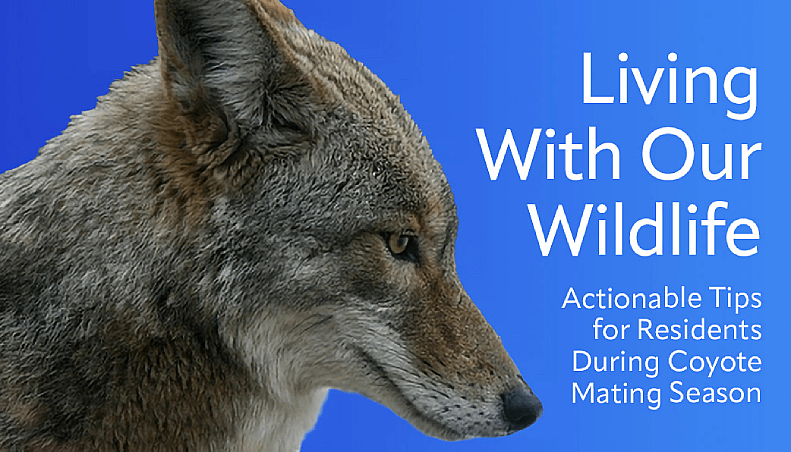As part of Environmental Affairs Advisory Board' "Environmentally Speaking" Library program, Lorain County's State Wildlife Officer Randy White, Ohio Division of Wildlife, discusses how we can live in harmony with the animals around us.
Environmentally Speaking: Coexisting with Nature from Avon Lake Community Television on Castus Cloud.
On the City's podcast, "Avon Lake Matters," host Jen Miller discusses coyotes with Cleveland Metroparks wildlife ecologist Jonathon Cepek, who provides valuable information to counter misinformation, ease fears, and co-exist with them in our community.
Coyotes are an important part of Avon Lake’s landscape, helping to control populations of rodents, rabbits, and other small animals. With a better understanding of coyotes and their habitat, we can coexist with these adaptable and cunning animals. Following simple rules and being coyote conscious can help reduce conflicts between humans, coyotes, and other wildlife.
If you spot a coyote in your neighborhood, there is no need to be alarmed unless they are acting strangely as is the case with any wildlife that is acting strangely. It is very rare compared to dog-human interactions for a coyote to come into actual physical contact with a person or pet, but if this occurs then it should be reported immediately.
While you do not need to report all coyote sightings, it is good to report any encounters with those who appear aggressive, fearless, sick, or whom despite the removal of all attractants, continue to frequent your property. In that regard, the City of Avon Lake has established a Coyote Hotline - please email us and report the following facts:
• When did it occur
• Where did it occur
• What happened
• Who observed it, including their contact information
• Special circumstances surrounding the incident, if any
For further assistance, please visit the Ohio Department of Natural Resources website or call 800-WILDLIFE (945-3543).
We have compiled the following answers to debunk coyote myths and provide humane techniques that are proven to drive coyotes away.
Answers to the most common questions about coyotes
Q. Is what I am seeing a coyote?
Q. Are coyotes only gray in color?
Q. Aren’t coyotes only found in rural areas?
Q. Where did these coyotes come from?
Q. Will a coyote kill my cat?
Q. Will a coyote kill my dog?
Q. What about attacks on people?
Q. Then what do coyotes eat?
Q. Why does there seems to be a large increase in the coyote population around me?
Q. Do coyotes hunt in packs?
Q. Is it unusual to see a coyote out during the daytime?
Q. Do coyotes interbreed with dogs?
Q. What are my options for dealing with coyotes if I don’t want them around?
Q. How to prevent conflict with coyotes?
Q. Where can I find some additional information?
Q. Is what I am seeing a coyote?
Some of the major characteristics to look for are a bushy black-tipped tail, yellow eyes and overall gray appearance. Often coyotes get referred to as wolves, however there are no wild free-ranging wolves in Ohio.
Q. Are coyotes only gray in color?
No. Coyotes can come in many colors. However, the black-tipped tail will almost always be present and all coyotes will have yellow eyes.
Q. Aren’t coyotes only found in rural areas?
No. Coyotes can be found throughout Ohio and are even a common inhabitant of cities because of their smaller size, varied diet, and adaptability.
Q. Where did these coyotes come from?
Coyotes were not reintroduced into Ohio. Starting in the early 1900s, coyotes started expanding their range likely due to the loss of other predators in the Eastern United States. As they came into the Midwest, some went north into Canada and expanded to the North of the Great Lakes while others expanded their range south of the Great Lakes. The first documented coyote in Ohio was in 1947, in Preble County. However, they may have been present in Ohio as early as 1919.
Q. Will a coyote kill my cat?
There are far greater dangers cats face when they go outside. When you allow your cat to roam freely outdoors, even for short periods of time, you expose them to threats such as cars, dogs, disease, poisons, and cruel people. If you want your cat to be safe, keep them indoors. While it is certainly possible for coyote-cat interactions to occur, there are ways to help avoid them. A study by Stubbs and Krausman (2009) looked at coyote-cat interactions in Tuscon, AZ. Over a three-month survey there were 36 interactions with 19 resulting in the cat being killed. In one interaction, the cat even chased the coyote off. However, 31 of the 36 (86%) of the interactions were between sunset and sunrise. The best way to keep your cat safe is to ensure that that it is indoors before sunset and that you leave no cat food or water bowls out overnight. A readily available food source will attract a variety of wildlife, including coyote.
Q. Will a coyote kill my dog?
Coyotes do not typically look to kill dogs. Most coyote-dog interactions occur when the dog is off leash and chases the coyote. In some rare cases, female dogs in heat left outside during the breeding season in February may be of interest to male coyotes for potential breeding. The best way to keep your dog safe is to keep it on leash when you are outside with it. Remember, there is a leash law in Ohio. Also, most adult coyotes weigh between 25 and 35 pounds and they seldom weigh more than 45 pounds. Even a cocker spaniel weighs the same or more than a coyote. Coyotes typically will not look to take on a dog larger than itself, viewing it as a fight they will not win. Even small dogs often prove to be too much of a hassle for coyotes to deal with. Although “attacks” on larger dogs are rare, coyotes will sometimes go after a large dog when they feel that their territory is threatened. This generally occurs during the coyote breeding season, which takes place from January through March. During this time, it is especially important not to let dogs outside unattended and to keep them on leashes when in public areas.
As a reminder, while keeping your dog restricted, invisible wireless electric fences do not stop other animals from entering your property.
Q. What about attacks on people?
Coyote attacks, especially in the Eastern U.S., are very uncommon. Conover in Resolving Human-Wildlife Conflicts found that annually there are only two coyote attacks on people in the U.S. with zero fatalities. Comparatively he noted that humans are over 300 times more likely to get attacked by a skunk than a coyote. In Northeast Ohio there has only been one documented “attack” on a person. The interaction occurred in the Chagrin Reservation in the early 2000s when a coyote ran up to a biker and bit his leg. However, that coyote was quickly trapped and consequently tested positive for rabies. No known, verified attack has occurred by a healthy coyote in Northeast Ohio on a human. However, you should treat ALL wildlife with respect and remember that they are all wild animals. In addition, you should never intentionally feed coyotes.
Q. Then what do coyotes eat?
A coyote’s diet mainly consists of small rodents. Gehrt (2006) evaluated coyote feces in Cook County, IL (Chicago area) and found 42% of their diet comprised of small rodents. While 22% of their diet consisted of deer, the majority of that is due to coyotes taking advantage of road killed deer. Coyotes will feed on any type of roadkill they can find. Also, a large portion of their diet consists of vegetative matter such as fruits and grasses. Pet food left outside, bird feeders, and compost piles are a convenient food source for wildlife, including coyote. This food source attracts a great amount of mice, chipmunks, squirrels and rabbits - all of which coyote regularly eat.
Q. Why does there seem to be a large increase in the coyote population around me?
The data from the Ohio Division of Wildlife suggests that the coyote population overall in Ohio is stabilizing. However, coyotes will move around and occupy new areas for several reasons. It could be that some younger coyotes are dispersing from their mother’s home range in the fall. It could also be that your area has an abundant source of rodents upon which they can feed. If you have bird feeders, it is a good idea to make sure all bird seed is cleaned up off of the ground daily to lower the number of rodents around your home. This food source attracts a great amount of mice, chipmunks, squirrels and rabbits - all of which coyote regularly eat.
Q. Do coyotes hunt in packs?
No. Coyotes live in family units usually consisting of only five to six coyotes. This family unit is made up of two adults and the young from the previous year. However, one major difference from their cousin the wolf is that coyotes are solo hunters. The only time you may see multiple coyotes hunting together is when the mother is teaching its pups how to hunt. However, even in these situations there is no coordinated attack.
Q. Is it unusual to see a coyote out during the daytime?
Coyotes have learned to adapt to city living very well. Especially in the spring and fall, you will regularly see coyotes out during the day. In the spring, they are spending more time looking for small rodents to feed their pups. In the fall, the previous years’ pups are forced to leave and look for areas unoccupied by other coyotes. Because of their great adaption to cities, they regularly hear doors slamming, dogs barking, people talking, etc. So, they get used to those noises when they are out moving around. This is much like living next to a railroad. Over time you get used to the noise of the trains going by. It is normal behavior for them to pay no attention to people. A good rule-of-thumb is that a sick coyote will look and act sick. They will have hair loss, stumble when they walk, or continuously approach and/or growl at people. If you notice any of these situations, email the Coyote Hotline.
Q. Do coyotes interbreed with dogs?
While biologically it is possible for coyotes and dogs to breed and produce offspring (called coydogs), the occurrence is not common. A study conducted by the Ohio Division of Wildlife in the 1980s found an occurrence rate of only 2% statewide. It is likely that most of these were in rural Ohio where it is much more common for dogs to be allowed to run freely on a landowner’s property.
Q. What are my options for dealing with coyotes if I don’t want them around?
In areas with human activity, coyotes will change their behavior so they are active when they are less likely to encounter humans. It is important to not let coyote get comfortable in your yard. If you see them, yell, clap your hands, or throw things near them (not at them). Although not as effective as removing food sources and hazing techniques, motion sensor lights, sounds, and sprinklers may deter coyote from entering your property. If used consistently, smell deterrents such as cayenne pepper, vinegar, and ammonia may also help deter coyotes.
We should always have a healthy respect for all wildlife. Coyotes are here to stay. Even if they are all removed from an area, other coyotes will move in to occupy the newly voided area. Coyotes are extremely adaptable animals and rapidly adjust to changing conditions. Wildlife managers have found that coyote populations can actually expand rather than decline in response to eradication attempts.
Q. How to prevent conflict with coyotes?
Healthy coyotes are typically wary of humans and will keep their distance. Most negative encounters with coyotes are caused by human behavior and are very preventable. Not feeding coyotes, staying on trails, and keeping pets on leash are the 3 most important things you can do to prevent coyote conflict. It is also very important to consider where you are.
In your yard: Coyotes are wary and easily frightened away unless they have been habituated. Remove food resources (pet food, garbage, fruit, vegetables, compost, bird seed, etc.) that attract coyotes and other wildlife. Scare away any coyotes you see in your yard and do not let them become comfortable. Coyotes can be scared by yelling, banging pans or throwing objects near them. When coyotes are comfortable in backyards, they may view small, unattended, pets that are running free, as prey. To a coyote, a small pet that is running free may not look any different than a rabbit or squirrel that are regular prey. Make sure you turn lights on in your yard before you let pets out at night to avoid any surprise encounters. As a reminder, while keeping your dog restricted, invisible wireless electric fences do not stop other animals from entering your property.
If you are outside your yard and potentially in a coyote’s territory (near a den or pups): Stay on approved trails. Research within Cleveland Metroparks shows that coyotes avoid well used human trails and will usually use other routes. Hiking or dog walking off trail increases your chances of encountering a coyote. If you encounter a coyote, understand that the coyote may view you or your pet as a threat. Coyotes may not run from you if they think their pups or pregnant mate are in danger. Coyotes mate in February and early March. Pups are born from mid-April through May. During this period, coyotes will act defensively toward perceived threats to the pregnant female or newborn pups. Domestic dogs may trigger coyote defensive behavior even if they are not aggressive towards the encountered coyote. Coyotes are protective parents and defend their young just as humans do.
Always keep your pet on a leash. Make sure your pet is under control and do not release or command it to attack a coyote. Dogs that bark or chase coyotes can cause a coyote to act defensively. On the very rare chance that a coyote does approach you directly or begins to follow you, do NOT turn and run because it may cause the coyote to chase you. Coyotes, like dogs, may instinctively follow things that run. Back slowly away so that you do not turn your back on the coyote. Back-tracking on the route you took, will often lead you out of a den area or away from protected pups. If you are on horseback, slowly leave the area by retracing your route.
If you feel threatened try to frighten the coyote away by shouting in a deep voice, waving your arms, throwing objects near (not at) the animal, and looking it directly in the eyes. Stand up if you are seated. If you are wearing a coat or vest, spread it open like a cape so that you appear larger. Carrying a whistle with you can aid in frightening a coyote.
Dr. Stan Gehrt, Ohio State University, has been studying coyotes in urban and suburban environments surrounding Chicago for over 20 years. His Urban Coyote Research Project website (https://urbancoyoteresearch.com/about-project) is filled with information on urban coyote ecology and provides additional information to avoid coyote conflict.
Steps to avoiding conflict with coyotes
(From Urban Coyote Research: https://urbancoyoteresearch.com/coyote-info/how-avoid-conflicts-coyotes)
1. Do not feed coyotes
2. Do not let pets run loose or be unattended
3. Do not run from a coyote
4. Report aggressive, fearless coyotes immediately
5. Do not create conflict where it does not exist
Sick, strange acting, and fearless coyotes
There is always a chance a coyote is sick or injured and may act strangely. Most coyotes are healthy, but they can occasionally get canine distemper. It is very rare compared to dog/human interactions for a coyote to come into actual physical contact with a person or pet but if this occurs then it should be immediately reported. According to the Ohio Department of Health (https://odh.ohio.gov/know-our-programs/zoonotic-disease-program/resources/rabies-brochure), if a person or pet is bitten by an animal, regardless of whether it's a pet or wild animal, the bite needs to be reported to the county health department where the bite occurred (Lorain County Board of Health, 440-322-6367). Bites from animals can spread rabies or other infections, so prompt reporting allows public health to take preventative measures and make recommendations. If an animal bite occurs within Avon Lake, notify the Avon Lake Police Department.
Q. Where can I find some additional information?
Urban Coyote Research
Summit Metroparks
Cleveland Metroparks
The Humane Society of the United States
Information from the Ohio Division of Wildlife
OSU Fact Sheet - Urban Coyotes
Coyote breeding season is from mid-January to mid-March. They become more active during this time.
To prevent conflicts with coyotes, residents are encouraged to stay alert and follow these actionable tips:

Remove food sources from yard (bird seed on ground, pet food, compost, garbage outside of bin).

Keep dogs on leashes at all times. Keep cats safe inside your home, especially from dusk through dawn.

Accompany dogs in yard dusk through dawn, even with a fence.

Deter coyotes from entering yard with hazing techniques (yelling, clapping, whistling, or throwing objects near them).
Springtime in the life of a coyote is defined by the birth of pups, following a 9-week gestation period in April and May. The number of pups produced is generally dependent on available food resources and the surrounding coyote population. In urban areas this can average around 6 pups. Raising young is a team effort, and the entire pack contributes to the success of a litter. For the next several weeks after birth, the mother spends her time primarily in the den with the pups. Both parents hunt for food and feed the young. However, the male takes the lead role when the pups are newborns, obtaining enough food for both his mate and offspring, and staying vigilant of the den sites. Within a few weeks, coyote pups are weaned and begin to exit the den to play and socialize with other pack members. By the time they are around 9 weeks old, den sites are abandoned, and the pups begin to travel along with the pack for the summer season.
Coyote sightings may decrease during the early spring as the pack sticks close to the den, which may be dug by the coyote or found in a variety of locations such as hollow logs, an existing burrow previously occupied by another animal, or a brushy thicket. However, it is important to keep caution when visiting these areas as this is a highly sensitive period for coyotes, and their behavior towards their litters can be extremely protective. Coyotes are an important part of Avon Lake’s landscape, helping to control populations of rodents, rabbits, and other small wild animals. Keep your distance and enjoy the wildlife viewing experience.
Coyote pups are due to be born in June. Typically, coyotes will move away when humans make loud noises, throw objects, or extend arms or devices (e.g., umbrella, coat). A coffee can or soda can filled half full with rocks makes a nice noise maker, and provides ammunition if needed. However, if a coyote is intent on defending a particular area or follows you during May and June, it is likely the coyote is guarding its family. Coyotes, like humans, are extremely protective of their pregnant mate and pups. If a coyote stands its ground or approaches you during this time of year, back away slowing while facing the animal and continue to act assertive using the techniques described above. Do not run away. Running triggers a pursuit response as in dogs. And please keep your pets on a leash.
Please note:
• A human with or without a pet may experience a type of behavior known as ‘escorting,’ where a coyote may follow at a closer distance than usual in order to remove you from the area of their den.
• Though hazing is usually recommended when in close contact with coyotes, hazing techniques during pup season can be ineffective and can further escalate any tense situations.
• The best course of action is to leave the area as confidently as possible, without running.
• Keeping pets on leash and close to you is crucial during this time.
• Never let your pets wander in an area with potential den sites. Coyotes are intolerant of dogs during this time and may bite or attack if they feel threatened.
Did you know that coyotes . . .
- are native to North America?
- typically are shy in nature?
- are omnivores, they eat meat, berries, grass, etc?
- use many forms of communication?
- mate for life?
- live in major cities?



